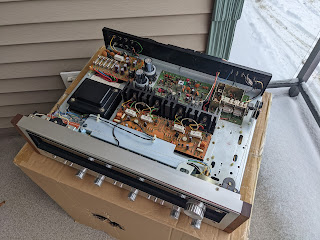This midrange receiver was one of the last few vintage pieces I've bought in Winnipeg. While by it only put out 25wpc into 8ohm, it was adequate to power my little Bozak MB80. This combination served me well during my transition to the interior BC.
It was more than adequate for my previous living space and even my current living conditions. Granted the Bozak prefer more power.
It was recapped by the previous owner, IIRC all the caps were replaced. That was the extent of the "restoration." It sounded very good for what it was. This Pioneer was on the middle to warm side of things of the sound signature. It was pleasant, wasn't mushy or overly "tubey" sounding but, not as dynamic or transparent as others.
Middle-ground stuff. Tuner was nice, it was able to grab signal in my condo without an antenna and sounded pretty decent. No qualms about the tuner. Everything worked as it should. Overall, I had zero issues with this unit. However, I was not a huge fan of the speaker binding post at the back. But, having some banana to spade adapters helped.
Certainly, in my opinion, I prefer the sound signature of the Pioneer SX-636 over the HH Scott 377B, that I picked up (stayed tuned!). This was a very capable unit for either a main or secondary system. I paired it to a TV using an external DAC and turntable. Made listening to music, and watching Netflix a breeze. The added tone controls were nice, especially to bump the bass on the Bozak for movies.
Physically, it was in very good shape, even the vinyl top was in good shape. It is sometimes interesting to see a solid wood case wrapped in vinyl.
I know recapping is a controversial issue but, I am the camp of: These units are 40+ years old, for reliability sake. Plus, the increased long term longevity is also nice.
While my unit was recapped, it did have some burnt out lamps. I tried to source them locally but, it was not possible.
Currently, this unit has found a new home in Alberta!
Some specification from hifiengine.com:
Tuning range: FM, MW
Power output: 25 watts per channel into 8Ω (stereo)
Frequency response: 20Hz to 30kHz
Total harmonic distortion: 0.5%
Damping factor: 35
Input sensitivity: 7mV (mic), 2.5mV (MM), 150mV (DIN), 150mV (line)
Signal to noise ratio: 65dB (mic), 70dB (MM), 90dB (line)
Output: 150mV (line), 30mV (DIN)
Speaker load impedance: 4Ω (minimum)
Semiconductors: 1 x FET, 3 x IC, 33 x transistors, 17 x diodes
Dimensions: 480 x 147 x 405mm
Weight: 11.2kg






